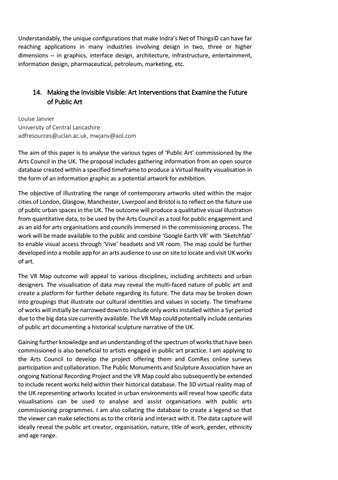Understandably, the unique configurations that make Indra’s Net of Things© can have far reaching applications in many industries involving design in two, three or higher dimensions -- in graphics, interface design, architecture, infrastructure, entertainment, information design, pharmaceutical, petroleum, marketing, etc.
14. Making the Invisible Visible: Art Interventions that Examine the Future of Public Art Louise Janvier University of Central Lancashire adfresources@uclan.ac.uk, mwjanv@aol.com The aim of this paper is to analyse the various types of ‘Public Art’ commissioned by the Arts Council in the UK. The proposal includes gathering information from an open source database created within a specified timeframe to produce a Virtual Reality visualisation in the form of an information graphic as a potential artwork for exhibition. The objective of illustrating the range of contemporary artworks sited within the major cities of London, Glasgow, Manchester, Liverpool and Bristol is to reflect on the future use of public urban spaces in the UK. The outcome will produce a qualitative visual illustration from quantitative data, to be used by the Arts Council as a tool for public engagement and as an aid for arts organisations and councils immersed in the commissioning process. The work will be made available to the public and combine ‘Google Earth VR’ with ‘Sketchfab’ to enable visual access through ‘Vive’ headsets and VR room. The map could be further developed into a mobile app for an arts audience to use on site to locate and visit UK works of art. The VR Map outcome will appeal to various disciplines, including architects and urban designers. The visualisation of data may reveal the multi-faced nature of public art and create a platform for further debate regarding its future. The data may be broken down into groupings that illustrate our cultural identities and values in society. The timeframe of works will initially be narrowed down to include only works installed within a 5yr period due to the big data size currently available. The VR Map could potentially include centuries of public art documenting a historical sculpture narrative of the UK. Gaining further knowledge and an understanding of the spectrum of works that have been commissioned is also beneficial to artists engaged in public art practice. I am applying to the Arts Council to develop the project offering them and ComRes online surveys participation and collaboration. The Public Monuments and Sculpture Association have an ongoing National Recording Project and the VR Map could also subsequently be extended to include recent works held within their historical database. The 3D virtual reality map of the UK representing artworks located in urban environments will reveal how specific data visualisations can be used to analyse and assist organisations with public arts commissioning programmes. I am also collating the database to create a legend so that the viewer can make selections as to the criteria and interact with it. The data capture will ideally reveal the public art creator, organisation, nature, title of work, gender, ethnicity and age range.
